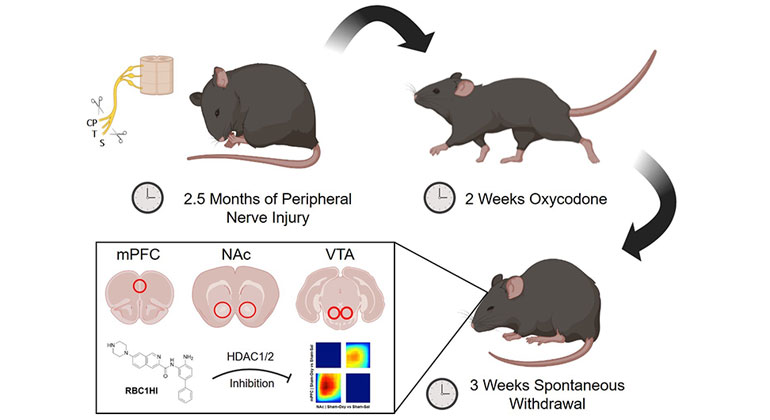Key Signaling Protein Associated with Addiction Controls the Actions of Oxycodone in Pain-Free and Chronic Pain States
RGS9-2, a key signaling protein in the brain known to play a critical role in the development of addiction-related behaviors, acts as a positive modulator of oxycodone reward in both pain-free and chronic pain states, according to a study conducted at the Icahn School of Medicine at Mount Sinai and published online January 17 in the journal Neuropsychopharmacology. The mechanisms of oxycodone action uncovered through this study will help scientists and physicians develop strategies and tools to dissociate the analgesic (pain relief) actions of opioids from the addiction-related effects.
Using mouse models of acute and chronic pain, Mount Sinai researchers found that RGS9-2, the intracellular protein that controls the function of opioid receptors in the brain reward center, promotes addiction to oxycodone in pain-free, acute, and chronic pain states. Mice that lacked the gene responsible for encoding RGS9-2 (RGS9KO mice) showed less propensity to develop addiction-related behaviors. Furthermore, the loss of RGS9-2 function does not affect the acute analgesic effects of oxycodone. The research team also found that RSG9-2 plays a protective role towards the development of oxycodone tolerance, as RGS9KO mice became tolerant to the analgesic effects of the drug earlier than those that had the gene. Researchers found that the same mechanisms control sensitivity to oxycodone addiction in pain-free as well as chronic pain states.
Oxycodone is a painkiller that is widely prescribed for acute and chronic pain conditions and is also among the most abused opioids. Oxycodone acts in the same brain receptors as morphine and heroin, the mu opioid receptors, which are present in many areas of the brain that mediate pain relief, but are also expressed in the brain network associated with addiction. While there has been extensive investigation into the mechanisms underlying the analgesia, dependence, and addiction potential of morphine, the mechanism by which oxycodone exerts its actions remained unknown.
“Although oxycodone produces similar analgesic and behavioral effects to those observed with morphine, our study demonstrates that the intracellular actions of morphine and oxycodone are distinct,” says Venetia Zachariou, PhD, Associate Professor in the Fishberg Department of Neuroscience and The Friedman Brain Institute, Icahn School of Medicine at Mount Sinai. “Our work reveals that intracellular factors that prevent the actions of morphine may actually promote the actions of oxycodone. This information is particularly important for pain management strategies, as a common course is to have patients oscillate between oxycodone and morphine to achieve pain relief.”
The Mount Sinai study provides new information on pathways involved in behavioral responses to oxycodone in pain-free and neuropathic pain states, which will help researchers and clinicians to determine the risks and benefits of oxycodone prescription for the treatment of pain. This knowledge may lead to the development of more efficacious and less addictive compounds for pain management.
This research was supported by the National Institute of Neurological Disorders and Stroke (NS086444).
About the Mount Sinai Health System
Mount Sinai Health System is one of the largest academic medical systems in the New York metro area, with 48,000 employees working across seven hospitals, more than 400 outpatient practices, more than 600 research and clinical labs, a school of nursing, and a leading school of medicine and graduate education. Mount Sinai advances health for all people, everywhere, by taking on the most complex health care challenges of our time—discovering and applying new scientific learning and knowledge; developing safer, more effective treatments; educating the next generation of medical leaders and innovators; and supporting local communities by delivering high-quality care to all who need it.
Through the integration of its hospitals, labs, and schools, Mount Sinai offers comprehensive health care solutions from birth through geriatrics, leveraging innovative approaches such as artificial intelligence and informatics while keeping patients’ medical and emotional needs at the center of all treatment. The Health System includes approximately 9,000 primary and specialty care physicians and 10 free-standing joint-venture centers throughout the five boroughs of New York City, Westchester, Long Island, and Florida. Hospitals within the System are consistently ranked by Newsweek’s® “The World’s Best Smart Hospitals, Best in State Hospitals, World Best Hospitals and Best Specialty Hospitals” and by U.S. News & World Report's® “Best Hospitals” and “Best Children’s Hospitals.” The Mount Sinai Hospital is on the U.S. News & World Report® “Best Hospitals” Honor Roll for 2025-2026.
For more information, visit https://www.mountsinai.org or find Mount Sinai on Facebook, Instagram, LinkedIn, X, and YouTube.
Mount Sinai Researchers Identify Brain Protein That Promotes Maintenance of Chronic Pain
Oct 16, 2019 View All Press ReleasesOpioid Abuse Initiates Specific Protein Interactions in Neurons in Brain’s Reward System
Feb 24, 2014 View All Press Releases